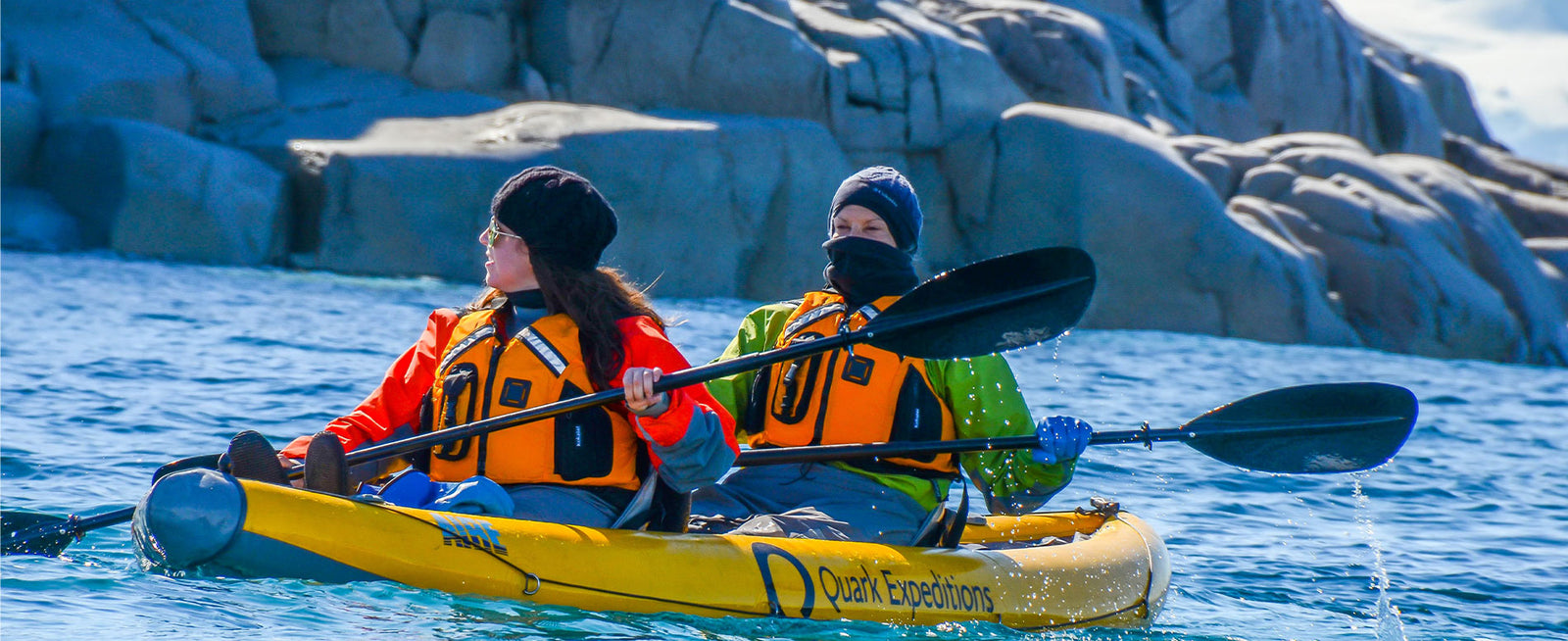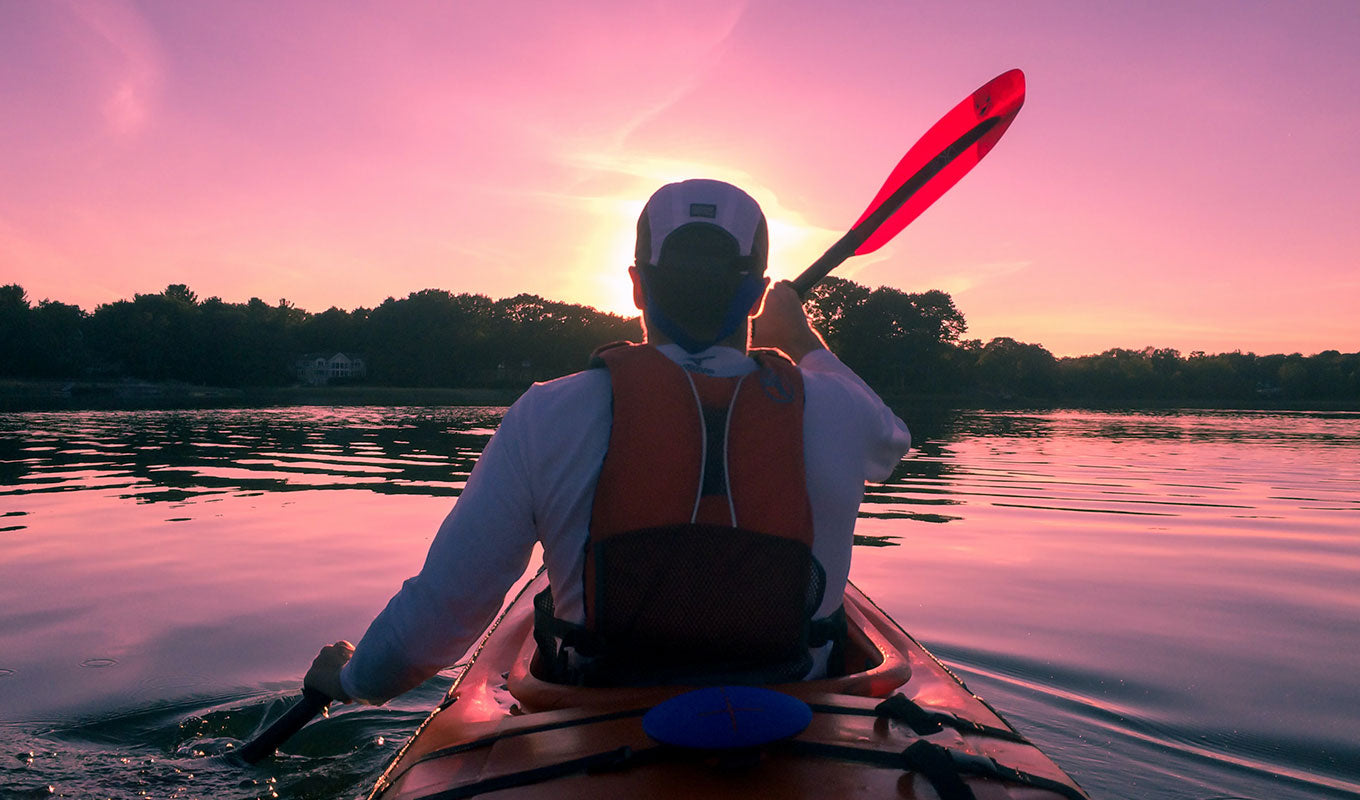Your Cart is Empty


Kayaking is literally one of the most immersive water sports. Whether you opt for a sit-inside or a sit-on-top kayak, you will get wet regardless. Therefore, what you choose to wear for kayaking is super important. Unlike SUP clothing, kayak clothing requires you to dress appropriately to the water temperature rather than the air.
This can be overwhelming for new starters to the world of kayaking to get their heads around. But don’t get put off!
We have compiled your ultimate kayaking dress code and guide, to make sure you are prepared from head to toe right from the start. Read on to learn more about layering, neoprene, and spray skirts. We cover all basis!
Table of Contents

When thinking about what to wear for kayaking, comfort is key. This is comfort against chafing and rubbing, comfort against the elements, and comfort while you are sitting for extended periods of time.
Chafing can happen for a variety of reasons kayaking and it is important to not underestimate how severe it can be. Simply put, chafing is irritation of the skin caused by friction – typically skin-on-skin or saltwater, but sometimes clothing-on-skin as well. Therefore, what you choose to wear to kayak can make or break your experience.
Generally, it is advised to avoid cotton material clothing as this can cause irritation when wet (especially when sea kayaking). Wearing neoprene as a base layer can significantly help when it comes to chafing as well.
As we mentioned in the intro, for kayaking you need to dress for the water temperature, not the air temperature. You can be paddling in the height of summer with near 90ºF air temperatures, but glacial waters will always be chilly when it splashes in your boat!
Unlike stand-up paddle boarding, there is no avoiding getting wet when kayaking. A kayak sits lower in the water and the paddler is often splashed in the whole process.
You may have already noticed a lot of wetsuits and dry suits worn by kayakers, depending on where you are in the world. Drysuits come into play when water temperatures regularly drop below 45ºF (7ºC).

Layers are the secret to staying warm and regulating your body temperature while kayaking. When done right, you can comfortably paddle in the coldest and harshest conditions without freezing yourself!
For the best results, use thin layers and build it up. This adds air layers to your clothing which is what will keep you warm while kayaking. Typically layers are used for warmth, but they can also be used for sun protection if the conditions require.
Base layers: quick dry tops, swimwear, lycra – anything that will wick away sweat while you are paddling your kayak.
Mid-layers: this could be anything from an additional wetsuit or fleecy layers to go under a dry suit/waterproof jacket.
Outer layers: drysuits, gilets, waterproof jackets designed to give you protection from the wind and other harsher elements. Kayak life jackets can also be considered an outer layer as they offer you extra warmth.
Here is a quick rundown of the kind of clothing you may need to add to your wardrobe to be prepared for kayaking adventures.
As seasons change, so does your kayaking wardrobe. From warm weather to cold weather, you need an outfit for every occasion.
Note: These recommendations are based on “standard” seasons for North America/the northern hemisphere. Adjust accordingly to your geographical location.

Spring is possibly the most difficult season to dress for kayaking.
The air temperature change can be dramatic, but the water temperature does not follow as quickly. Many people get lulled into a false sense of security and dress down when really they should be preparing for icy cold waters. The rivers are flowing with melting ice from the mountains!
What to wear in Spring to kayak?

Recreational comes into its own during the hot and steamy summer months.
Depending on where you are kayaking, you may be blessed with sunny days and equally warm waters. Even if the water is still fresh, this could be a pleasant cool down especially if you are on the beach.
What to wear in Summer to kayak?

Fall is another difficult season to dress for as the weather turns. However, unlike Spring, the air temperatures tend to fall faster than the water temperatures. We will repeat it again – dress for the water, not the air.
What to wear in the Fall to kayak?

Obviously the winter brings the coldest conditions to paddle in. With super cold water comes a seriously dangerous hazard.
In order to combat the cold, you will need to wear water-resistant clothes and plenty of layers to keep you warm while kayaking.
What to wear in Winter to kayak?

Want to level up your kayaking experience and head out after dark? Make sure you dress the part.
As with any kayak session, you need to dress for the temperatures you will be paddling in. So if you are wearing a wetsuit or drysuit during the day, the night is no different. In fact, you may even want to add another layer just in case there is more of a chill in the air. You can pack an extra layer in a dry bag to put on mid-paddle if you plan to stay out for a long time.
Nighttime paddling also requires lights for safety purposes. Think about getting hold of a head torch so you can see where you are going!
Both wetsuits and dry suits are often used for kayaking. Choosing which one to go for is decided by the water temperature you are paddling.
Wetsuits are made out of neoprene and range in thickness from 1mm to 7mm. They insulate the body and retain the heat by allowing a layer of water to sit between the skin and the neoprene – a thermal barrier. Typically, wetsuits are worn during activities that are fairly physical, which maintains the warmth within the suit. As the name suggests, you still get wet wearing a wetsuit.
Drysuits on the other hand keep the wearer completely dry. These fully waterproof suits need layers underneath them (like fleece and other base layers) to give the warmth needed for cold conditions.
Both are a crucial part of a kayaker's wardrobe in order to avoid hypothermia and help prolong your kayaking session.
So, when do you wear a wetsuit and at what point do you level up to a drysuit?
| When to use | Pros | Cons | |
| Wetsuit | When the water is cold enough to potentially drop core body temperature dangerously low, but the air temperature is warm enough.Example: paddling a large body of water, like a lake. |
- Flexible and non-restrictive -Large range available in different thicknesses and styles - Still functional with a small tear/rip |
- Can be difficult to put on and off, especially when wet - Not suitable for waters below 45ºF |
| Drysuit | Generally used in cold regions where water temperatures drop below 45ºF. Often seen worn by kayakers paddling rivers in winter months. |
- Can keep you warm in extreme cold (with the right layers underneath) - Highly adaptable to wear kayaking, depending on what you put on underneath - No need to shower or dry off after your paddle, just remove the drysuit |
- Bulky and restrictive - Can be sweaty to wear kayaking if conditions warm up- If damaged, they are redundant at keeping you dry - Awkward to have a mid-paddle bathroom stop! |

Layering is the key to staying warm whilst kayaking. Whether you are wearing either a wetsuit or a dry suit, you can still layer up to get more comfortable and maximise your paddling performance.
Wetsuits are more limited when it comes to layering. You can add an additional lycra rash guard underneath the neoprene. This will act as an extra thermal layer and you will notice the difference. However, if you are thinking about adding an extra layer to a wetsuit for warmth, then you should probably consider levelling up to a dry suit.
Drysuits are where the layering game really comes into action for cold weather paddling. A drysuit alone is not a warm piece of kit, it is what you wear underneath that makes the difference. The best layers to consider are:
In addition to the layers underneath, you can add on a life jacket and zip-up waterproof jackets. Both of these act as a barrier against the wind and spray – extremely welcomed when whitewater kayaking in cold conditions.
Spray skirts are a piece of equipment designed for both comfort and safety.
They are typically used by more advanced paddlers in whitewater kayaking situations. The spray skirt is attached to the kayaker and the cockpit of a sit-inside kayak, acting as a lid to a container. It keeps water out of the kayak while also keeping the kayaker inside!
Using a spray skirt is often a personal preference. Some people do not like paddling with them as they can feel trapped. Kayakers should be skilled enough to either Eskimo roll the kayak or detach the spray skirt if they capsize.
When kayaking in warmer weather, a spray skirt can make the inside of the kayak too hot. However, if you plan on kayaking in choppy waters, they are recommended to keep water out of the kayak which would otherwise destabilize and swamp the boat.

A life jacket ensures safety while you are out on an epic kayaking adventure. They can also add an additional layer of warmth to what you wear kayaking.
But you cannot simply pick up any old PFD (personal flotation device) and go out kayaking. There are some qualities it will need to have in order to make your experience comfortable and enjoyable.
Women’s kayaking clothing is similar to the wardrobe used for women's paddle boarding and the same as what men wear kayaking. It may be necessary to wear a dry suit or a wetsuit, depending on the air and water temperatures.
For cold weather kayaking, women can wear multiple layers of clothing under a dry suit to maintain a comfortable temperature. Fleece lining base layers are highly recommended and prove effective.
First-time kayakers should wear whatever waterproof clothing they have available. If renting a kayak or joining a tour, the outfitter should provide any necessary drysuits or wetsuits. The main thing beginners need to remember is to dress for the water temperatures and be prepared to get wet/fall in.
Neoprene booties or water shoes are always a good option of footwear for kayaking. They provide warmth and protection from colder climates which will allow you to stay out for longer.
You can paddle with sneakers on. However, this could get uncomfortable as they get heavier with water. Chances are you will be focusing on how uncomfortable the shoes are and not your paddling technique.
Barefoot is an option for hot weather and water conditions. This is a common recreational choice for those having a gentle beach kayaking trip.
Yes – in kayaking expect to get wet. You are sitting low to the water, some kayaks you are even below water level. Unlike stand-up paddle boarding, there is no way of escaping getting wet while kayaking.
Comments will be approved before showing up.